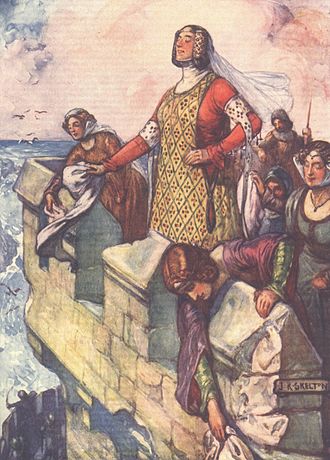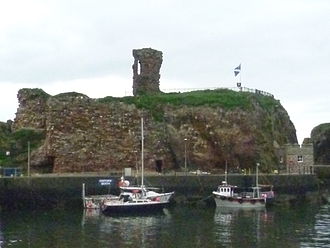Agnes, Countess of Dunbar was also known as Black Agnes because of her black hair and eyes and also her sallow complexion. She was married to Patrick. 9th Earl of Dunbar and her parents were Thomas Randolph, Earl of Moray and Isabel Stewart of Bonkyll. The main reason we remember Black Agnes is because of her heroic actions when Dunbar Castle was laid siege to by the English During the Second Scottish War for Independence from 1331 to 1341.

On January 13th, 1338 while Patrick was away, the English thought it would be a good time to lay siege to the castle thinking it would be easy because the only people that were there was Lady Agnes, some servants and a few guards. What they didn’t expect was the pure power and determination of Black Agnes against the vastly stronger 20,000 English army. She was said to have said
”Of Scotland’s King I haud my house, I pay him meat and fee, And I will keep my gude auld house, while my house will keep me.”
Woman at the time were known to take charge of their household while the men were away and if they had to they would defend. The siege was led by William Montagu, 1st Earl of Salisbury and his first method of attack was to launch large rocks into the castle and fire lead shot against the ramparts, but all Agnes did to counter this was to have one of her ladies-in-waiting dust the ramparts off with her kerchief. This did not please the English so they started employing a large siege tower called a ‘sow’ in an attempt to storm the castle, but all Agnes did in return was say, “take good care of his sow, for she would soon cast her pigs within the fortress.” and she then gave the order that the large boulder, that was launched at them earlier, was to be pushed from the battlements and it crushed Salisbury’s sow right where it stood.
When Salisbury was unable to make any progress using force he turned to bribery and tried to bride the Scotsman who guarded the main entrance to the castle to leave it either unlocked or in such a way that they could easily break into the castle. Though the Scotsman took the money he reported it to Agnes so that they were ready for the English when the time was right. They dropped the portcullis after the first man entered thinking that Salisbury would be leading the charge but it turns out one of his men had pushed past him so they were unable to capture him but instead they had once again stopped one of his attempts to take the castle and taunted him by saying, ” Farewell, Montague, I intended that you should have supped with us, and assist us in defending the Castle against the English.”
At one point Salisbury captured Agnes’s brother, John Randolph, 3rd Earl of Moray and they threw a rope around his neck threatening to hang him if Agnes didn’t surrender the castle to them, but she just replied with a go-ahead because if he died then she would get his earldom, though she would get no such thing, but the English didn’t know this.
As one final attempt to take the castle the English cut off all contact with the outside world trying to starve the people inside but they didn’t expect a man called Ramsay of Dalhousie, who had been a thorn in the English’s King’s side moved from his post in Edinburgh to Dunbar in order to help the Countess along with forty other men. They approached the castle by sea and snuck into the castle through the postern. They charged out of the castle and they managed to push the unexpecting advanced guards back all the way to their camp.
After five months Salisbury gave up the siege on the castle on June 10th 1338, but that win over the English for the Scots became a ballad which put these words in Salisbury’s mouth,
”Cam I early, cam I late, I found Agnes at the gate.”


My grandmother’s grandfather was Henry Dunbar. I know that he died in Paradise, California.
My great grandfather died in a mine in Pennsylvania, called the Dunbar mine.
Sounds fantastic what a strong and striking in her looks female. Wonder if her dna is shaping some women in the world today
Legend has it that king Robert de Bruce”s mother married his dad in a most unusual way she rode out of her castle with her solders found young Bruce and promptly took him off to her castle and kept him under lock and key until she had her way with the young jouster,
the rest is history as they say but good to see powerful female figures from times long past.
Oh there was that Irish princess who settled in Scotland and many a legend was based on her life’s work that’s going back a long way before the Bruce’s came to power in Scotland
I composed a piper’s ( anthemic) lament dedicated to Black Agnes of Dunbar called ”Black Aggie is there” in 2010 during the 38th year of my 40year Australian Defence Force Military Band career and scored it for full Military Band. Such is her inspiration to me as a gentleman Piper and devotee to Robert the Bruce.
Doing genealogical research I was delighted to find out that Agnes is a great grandmother of mine. For what it’s worth, my mtDNA is J1c2, so if I did everything correctly then that’s Agnes’s mtDNA also.